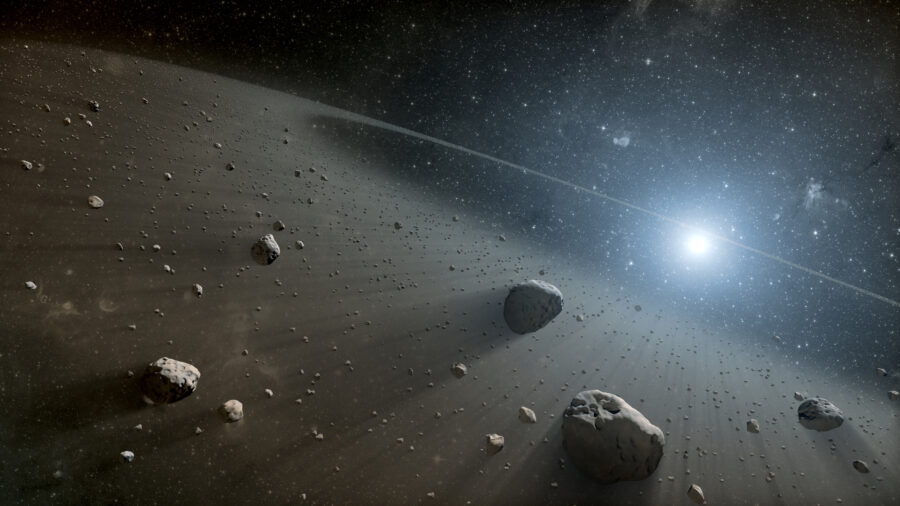Scientists have discovered the first meteorite that doesn’t fall into one of two fundamental groups. The meteorite provides a unique glimpse into the era of asteroid formation and migration.

NASA / JPL-Caltech
A fireball embellished the night sky over India on January 23, 1870. Accompanied by a thunderous detonation, the fiery mass crashed in the village of Nedagolla with enough force to leave the bystanders stunned. The impact left behind a bit over 4 kilograms of cosmic rock — the Nedagolla meteorite.
The meteorite would be just another one among thousands found on Earth if it weren't for its unusual composition. Researchers have long tried to understand its origin, and now they might have solved the mystery. In a recent study to be published in Meteoritics & Planetary Science (preprint available here), scientists found that the Nedagolla meteorite is a product of a collision between two asteroids of distinct origin. Its unique history opens up a new window into the research of the early stages of solar system formation.
Two Meteorite Families
Meteorites are time capsules that illuminate the era of planet formation. The solar system formed from a cloud of interstellar gas and dust that collapsed under its own gravity. Particles within the resulting protoplanetary disk collided and stuck, forming ever larger planetesimals, which became the parent bodies of the meteorites found on Earth.
Meteorites come in different flavors. Depending on whether iron or silicates dominate, meteorites are traditionally classified as iron, stony, or stony-iron. Composition also depends on whether the meteorites originate from bodies that underwent melting, or whether the parent body was unmelted and therefore more pristine. By these classifiers, Nedagolla is an ungrouped iron meteorite.
But one can also look at isotopes. Isotopes are elements with the same number of protons but a different number of neutrons, and they can carry a lot of information, including the time of a rock’s formation.
"About 10 years ago, the community realized that there is an isotopic dichotomy in meteoritic material," says graduate student Fridolin Spitzer (University of Münster, Germany), who was first author of the new study. Cosmochemists thus use isotopes to classify meteorites of all sorts, regardless of their chemical composition, as either non-carbonaceous chondrite (NC) or the carbonaceous chondrite (CC). (These groups were initially differentiated by the amount of carbon, but now the terms are used more generally.)
There is only one exception: "Nedagolla is the first one that does not consistently fall into one of the two categories but seems to fall in between," says Spitzer.
Scientists suspect that the two isotope classes formed in two different parts of the protoplanetary disk: The NCs in the disk’s inner part and the CCs in the outer solar system, beyond the Jupiter´s orbit. So where does that put the Nedagolla meteorite?
Asteroid Migrations and Collisions
After performing a new and independent analysis of the meteorite's composition, the team proposes that its unique isotopic imprint comes from a collision of NC and CC planetesimals. "The two bodies collided, and this induced melting because of high impact velocities, and it induced mixing of materials from these two bodies," explains Spitzer.
Here things become interesting. Most meteorites originate from the asteroid belt, a region between the orbits of Mars and Jupiter. So, the CC-type meteorites had to migrate to the inner part of the solar system at some point, otherwise the Nedagolla meteorite wouldn´t exist.

Bermingham et al. 2020
"The reason why we have any CC material to analyze on Earth, which is in itself an NC body, is because, during the disk evolution, planets like Jupiter migrated inwards and outwards, scattering material around the Solar System," says Katherine Bermingham (Rutgers University).
But the details are still murky. For example, did Jupiter’s movements create the isotopic divide? And why did one region of the disk have a consistently different mixture of material compared to the other?
With the Nedagolla meteorite, scientists obtained the first isotopic evidence that the NC and CC bodies mingled. Its composition suggests that at least the CC body had a metallic core. Furthermore, the formative collision couldn't have happened earlier than about 7 million years after the disk’s formation.
Such information measured for a larger sample of similar meteorites would be invaluable. "I think it is important that the community does more of this kind of work to see if we can figure out better time constraints on NC-CC mixing," says Bermingham. "There are a lot of ungrouped iron meteorites out there, and maybe this signature will be found in those that we haven't studied yet."
 3
3









Comments
Anthony Barreiro
September 22, 2021 at 3:05 pm
According to https://www.mindat.org/loc-263406.html , Nedagolla village was in what is now called the Vizianagaram District, Uttarandhra Region, Andhra Pradesh, India. At least according to Google maps, the village name Nedagolla is no longer an official geographic place name.
You must be logged in to post a comment.
goodricke1
September 24, 2021 at 4:40 pm
There is an alternative name for the meteorite, Nidigullam, but that doesn't seem to be recognised by Google Maps either...
You must be logged in to post a comment.
Steven-Rudnick
September 25, 2021 at 3:48 pm
Astronomers seem to be behind the curve on this one. Read "the Second Kind of Impossible" by Dr. Paul Steinhardt. Not only is it a great read, but he discovered what is accepted to be a meteorite in SIberia with a strange composition which seems to match the description here.
You must be logged in to post a comment.
You must be logged in to post a comment.